ChatGPT vs. Google AI Mode: Which Is Better for Productivity & Research?
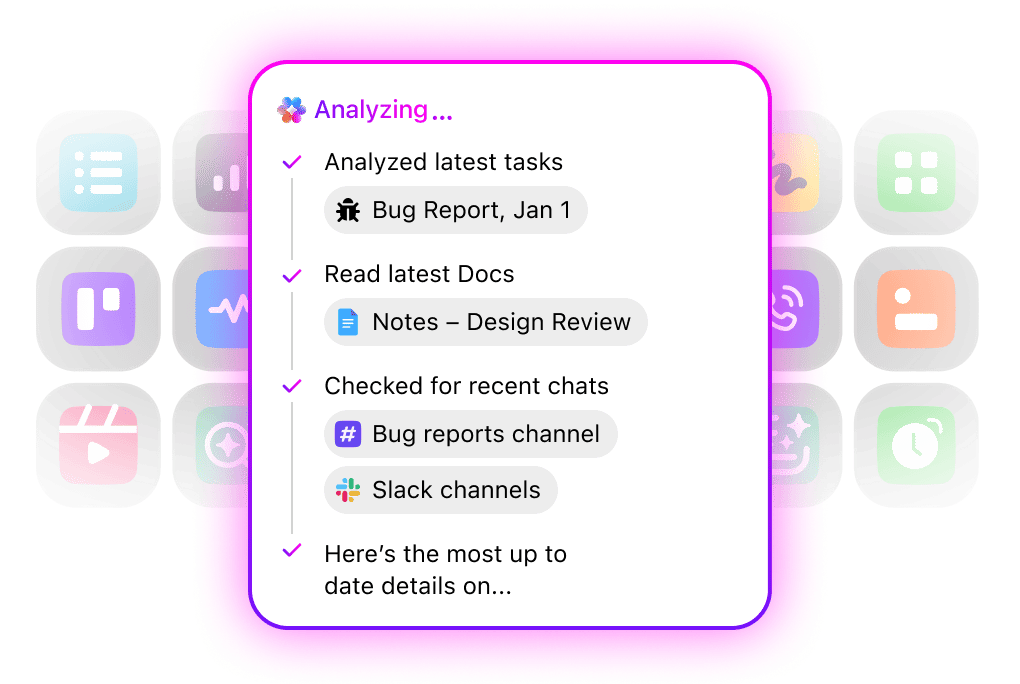
Sorry, there were no results found for “”
Sorry, there were no results found for “”
Sorry, there were no results found for “”

Some days, it feels like your brain is running a marathon. Jumping from drafting a report to digging up facts, all while trying not to lose sight of the real work.
That’s where AI can give you a breather. But do you turn to ChatGPT, the generative AI companion that remembers context and helps shape your ideas, or Google AI Mode, the information-hunting assistant with up-to-the-minute answers?
In this blog post, we’ll pit ChatGPT vs. Google AI Mode to see how they fit into your workflow, their impact on productivity and research, and how ClickUp brings the power of both, and more, under one roof. 💪
Here’s a table comparing these AI search engines:
| Capability | ChatGPT | Google AI Mode (Gemini in Workspace) |
| Primary function | Conversational AI for writing, brainstorming, coding, and Q&A | AI assistant built into Google apps |
| Task management | No built-in task manager, but can generate task lists/checklists | Can auto-generate action items from emails/Docs, but no full task manager |
| Scheduling | Suggests schedules but doesn’t connect directly to calendars | Integrates with Google Calendar to suggest meeting times, set reminders, and auto-schedule events |
| Collaboration | Shareable chats and documents, but no real-time co-editing or native teamwork features | Deeply collaborative inside Workspace; real-time editing, suggested replies, team notes |
| Integrations | Plugins and APIs for external tools; requires setup | Natively connected to Gmail, Calendar, Drive, Meet, and Docs; limited external integrations |
| AI capabilities | Strong at creative generation (content, code, brainstorming) with multiple AI models | Contextual assistance inside Google Workspace (summarization, drafting, meeting notes, smart replies) |
| Pricing* | Free version, Paid starts at $20/month per user | Free version, Paid starts at $19.99/month per user |
Our editorial team follows a transparent, research-backed, and vendor-neutral process, so you can trust that our recommendations are based on real product value.
Here’s a detailed rundown of how we review software at ClickUp.
ChatGPT is an advanced conversational artificial intelligence developed by OpenAI, trained to understand and generate human-like text using deep learning and other AI techniques.
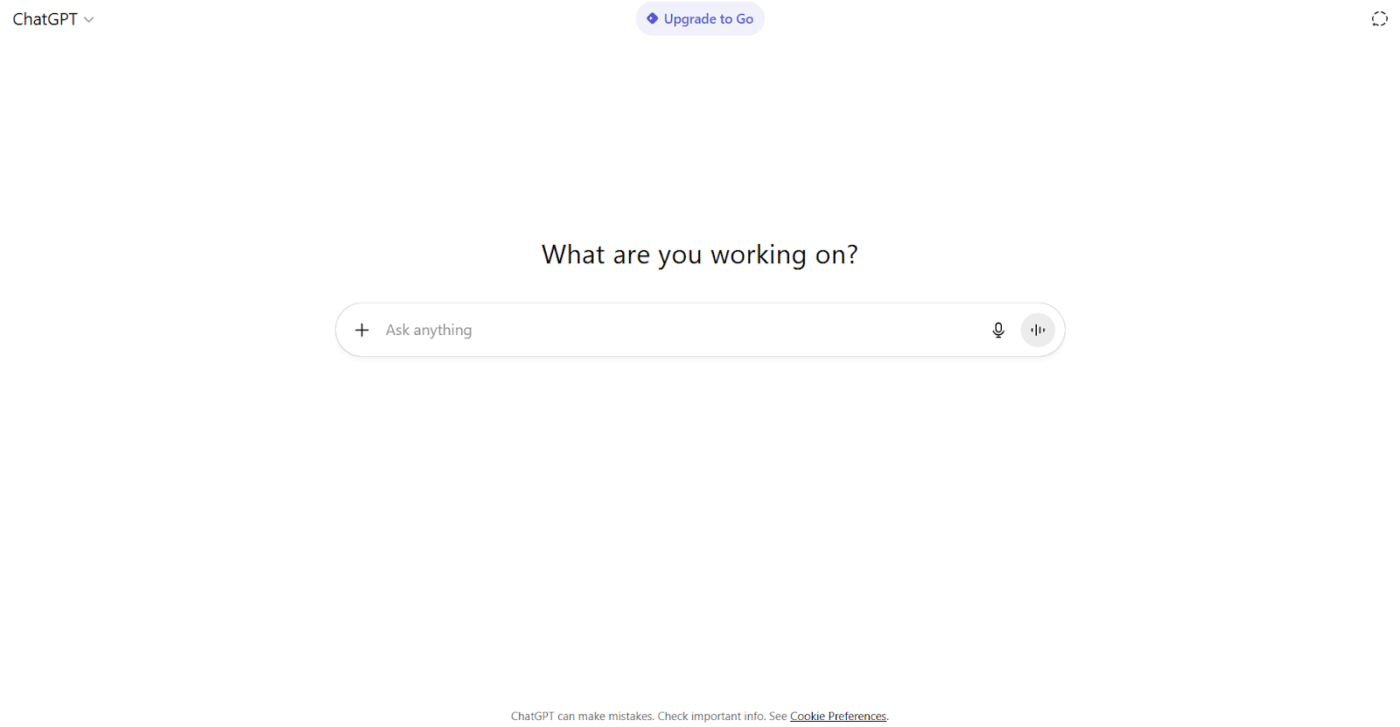
It can respond to questions, help draft content, brainstorm ideas, simplify complex topics, and even write code or translate between languages, making it a versatile assistant for both productivity and creativity.
Powered by models like GPT-4o and GPT-5, it adapts to context and tone to deliver responses that feel surprisingly natural and intelligent.
Let’s explore three of its most distinctive, standout features.
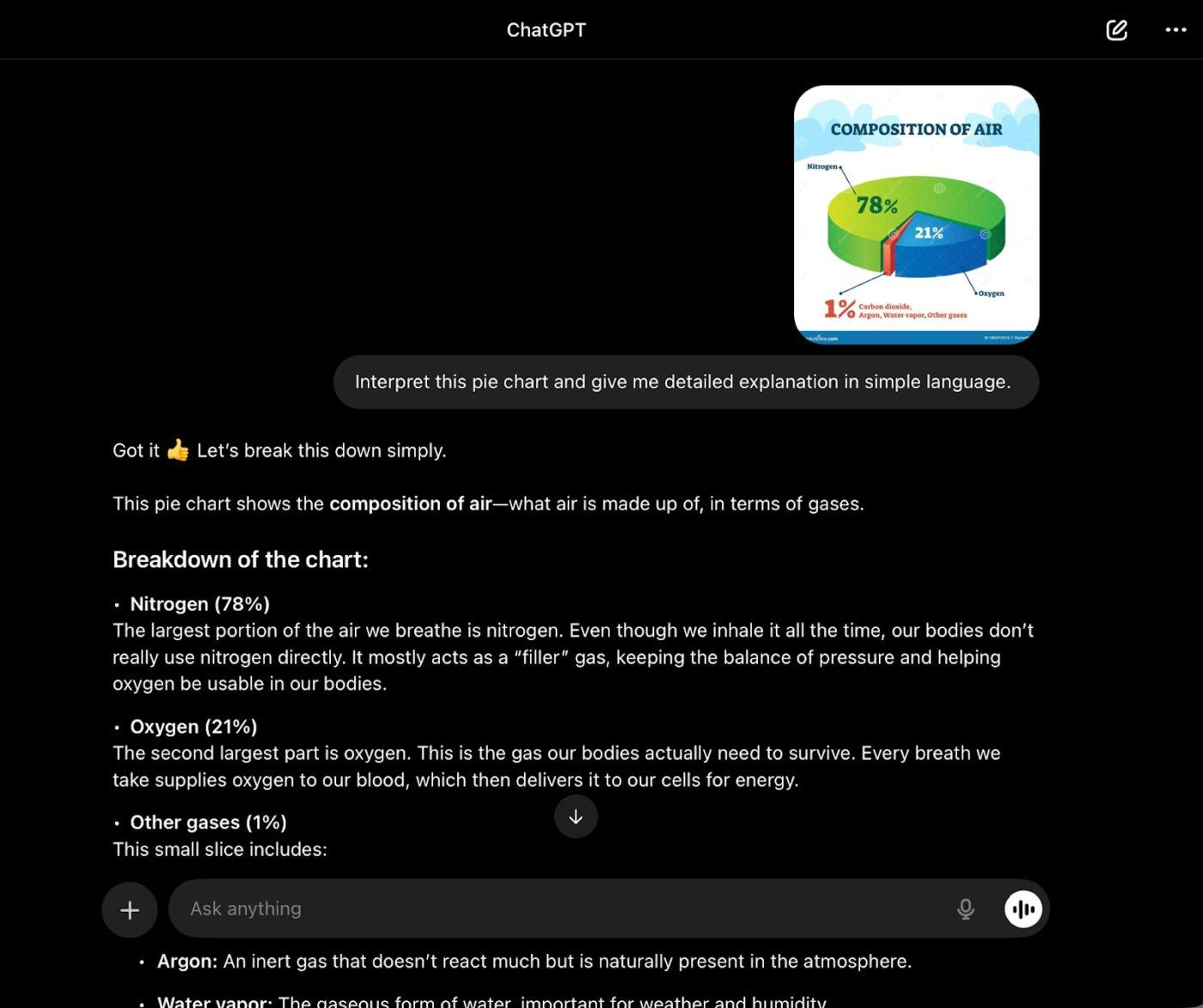
ChatGPT enables users to type, upload images, files like PDFs and CSVs, or speak directly with the interface. It interprets charts, extracts information from documents, analyzes spreadsheets, and creates or explains visual content.
This multimodal capability proves especially useful in applications such as presenting comprehensive reports, simplifying data-heavy presentations, and assisting in dynamic data analysis sessions.
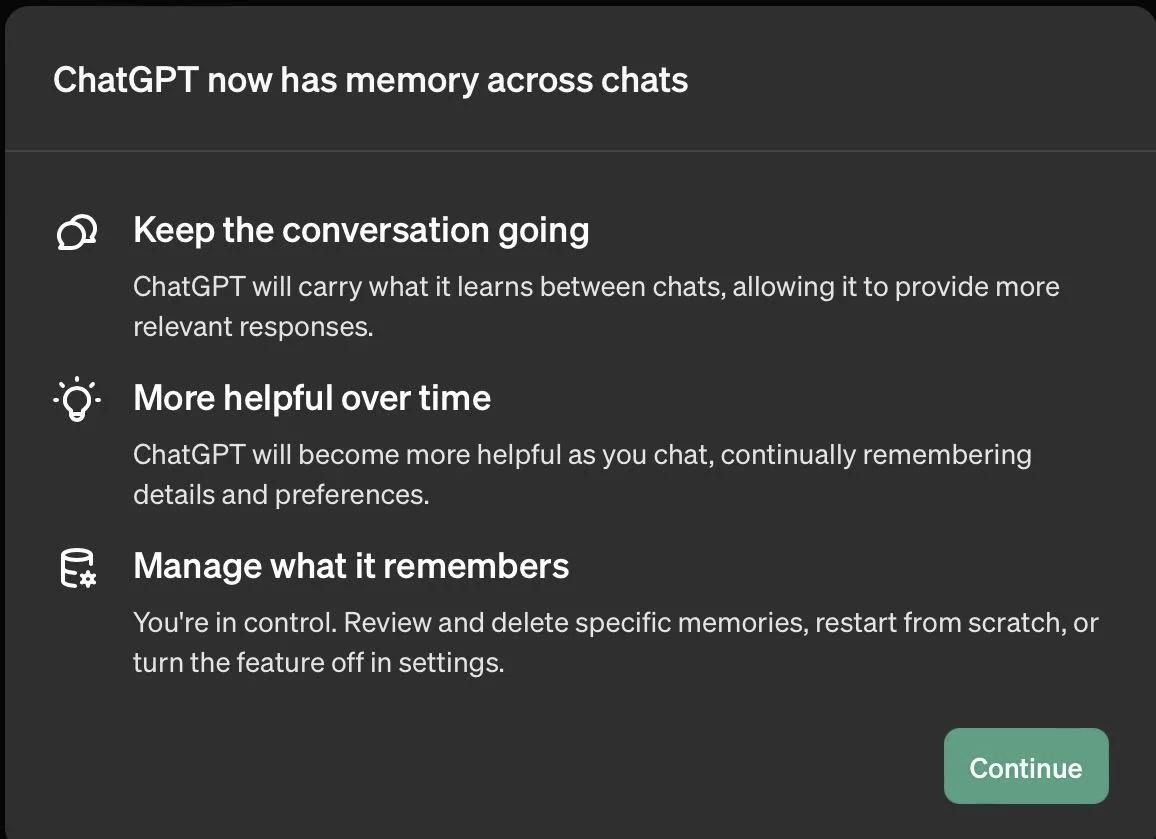
ChatGPT adapts to your work style. Its memory can keep track of your preferences, remember names, and hold onto details about ongoing projects so replies fit your context.
You can also set up custom GPTs that act as focused assistants for specific tasks, such as writing guidance or coding support. If you’re using the mobile app, voice input and output make conversations feel more natural and give you a hands-free way to interact.
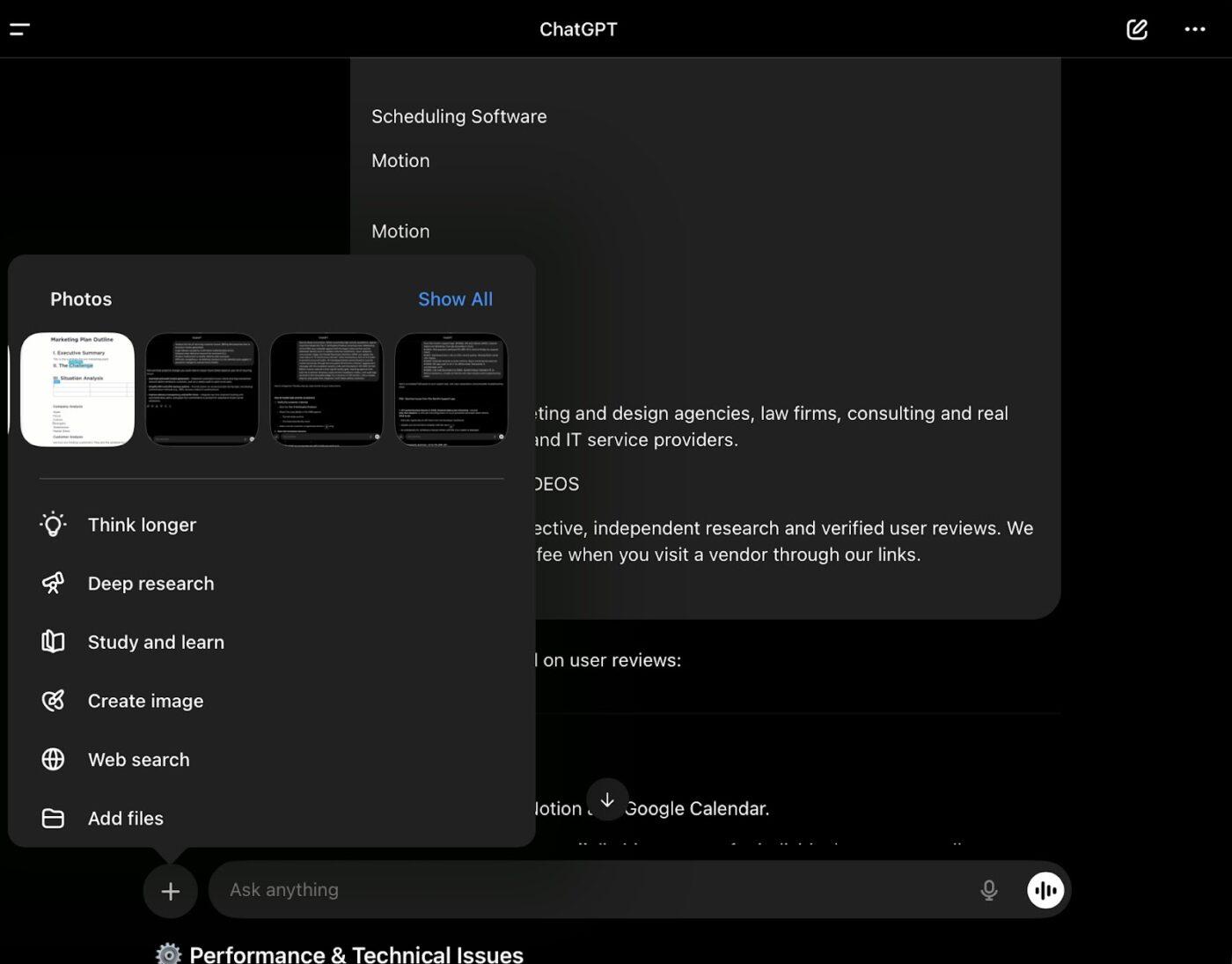
Use ChatGPT for research by pulling in up-to-date information and asking for sources and references. You can also rely on it for tasks like logical reasoning, summarization, and language translation.
Beyond that, advanced features like code execution and the ability to work with different tools allow you to handle more complex workflows.
🔍 Did You Know? One large-scale study showed that researchers who ised AI published 67% more papers, got 3x more citations, and became team leads roughly 4 years earlier than peers who didn’t use AI tools.
🎥 Watch: ChatGPT not cutting it for your advanced AI needs? Try ClickUp Brain
Google AI Mode is an intelligent search engine built into Google, designed to handle layered, context-rich queries with conversational ease.
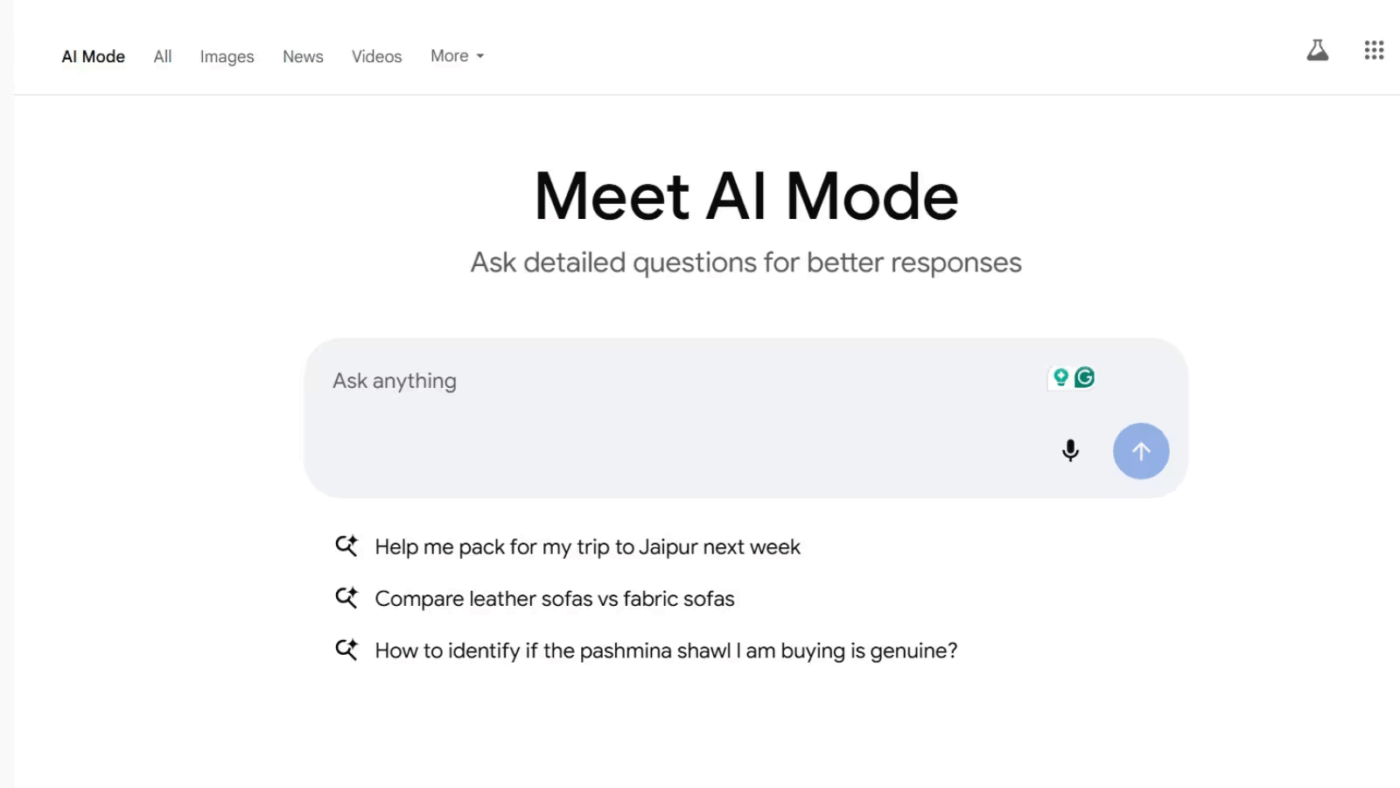
Powered by Gemini’s advanced versions, it breaks down complex questions, draws from multiple sources, and delivers synthesized, accurate answers directly in the search interface, without forcing you to click through pages.
Available via Search Labs in various regions, it supports voice, image, and text inputs to make search feel more fluid, intelligent, and responsive.
📖 Also Read: Gemini vs. ChatGPT for Writing: Which is Better?
Here are its best features.
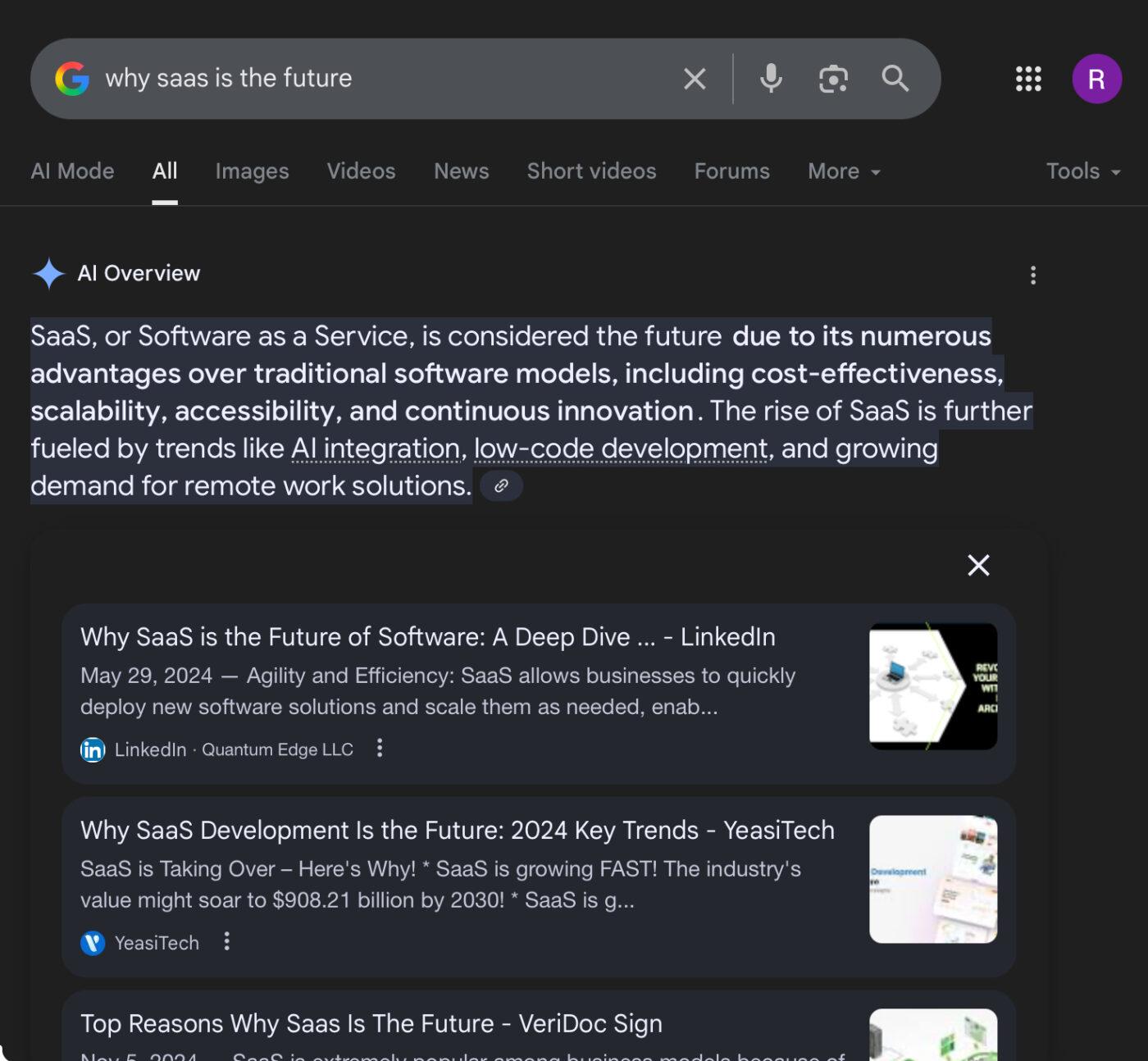
Speak, type, or point the camera, and AI Mode will process all of it. Whether you’re asking via text, voice, or image (or uploading PDFs), it understands and synthesizes information across formats.
Using Google Gemini’s multimodal capabilities and a ‘query fan-out’ strategy, it divides complex prompts into sub-questions, searches them in parallel, and unifies the findings in a summary.
💡 Pro Tip: Use specific timeframes to keep answers relevant. Ask what changed between 2019 and 2023 or specify post-pandemic developments. It keeps the model from mixing old and new info without distinction.
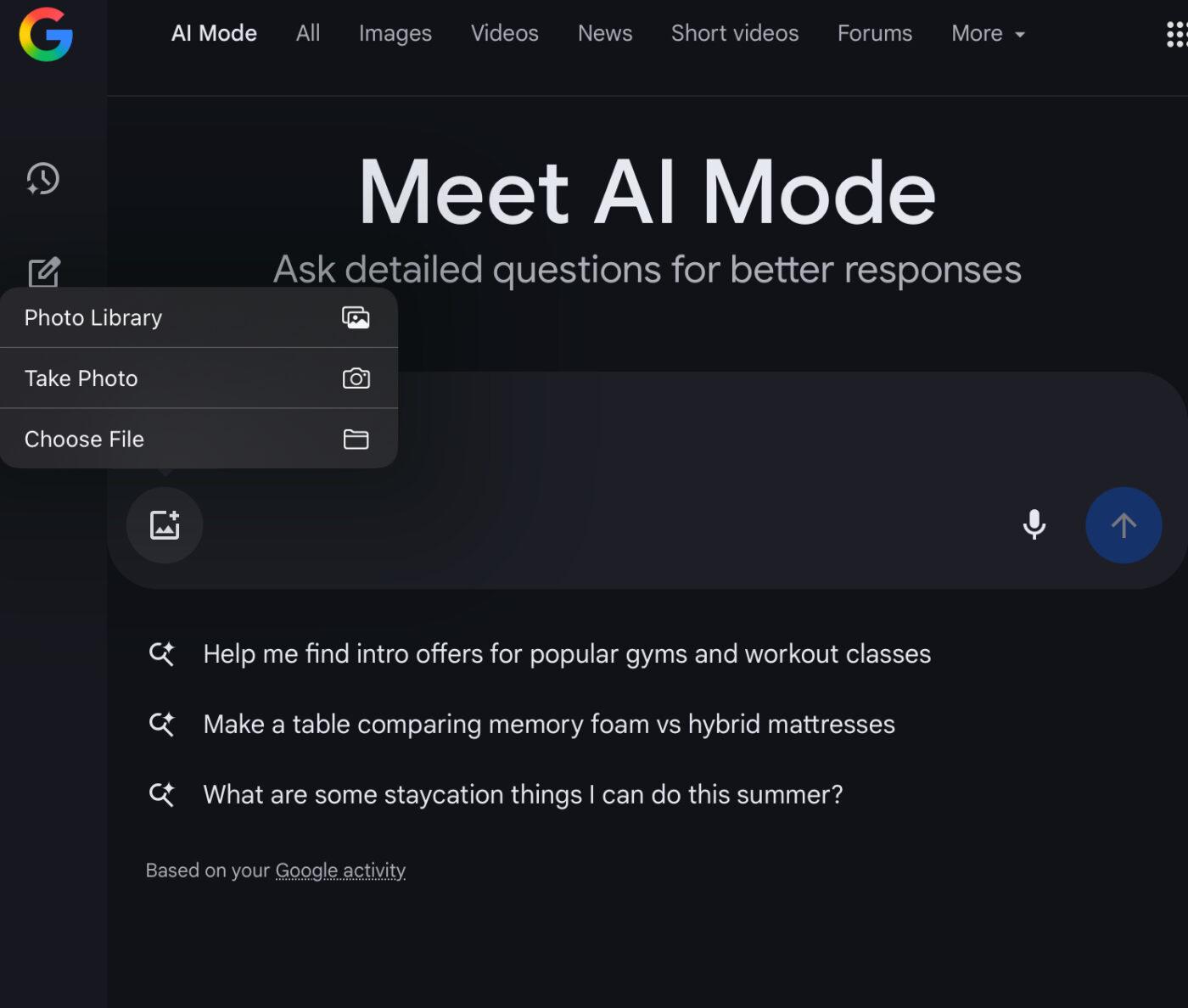
AI Mode’s side-panel ‘Canvas’ acts as a living workspace, making it ideal for planning, multi-stage tasks, or market research with AI. Draft plans, upload documents, fine-tune ideas with follow-up questions, and come back later to build where you left off.
It effectively shifts Google search from a one-off lookup to a collaborative session that evolves over time.
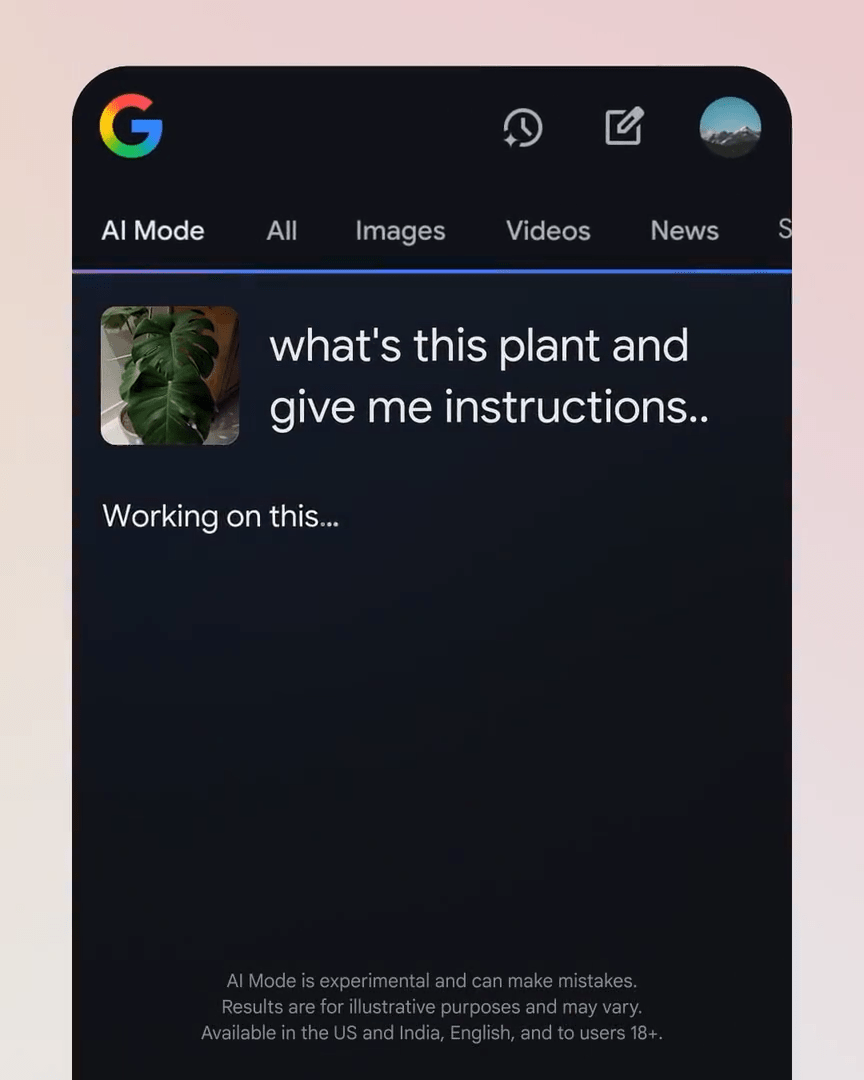
Need help interpreting what’s in front of you? AI Mode integrates Google Lens with real-time AI via ‘Search Live.’ Just point your mobile camera at an object or diagram to ask about it.
On desktop, Chrome’s new ‘Ask Google about this page’ option lets you explore page content in a context-sensitive sidebar.
🔍 Did You Know? AI can automate about 57% of idea-generation tasks. Top researchers leverage that to focus on vetting and refining suggestions, leading to 44% more discoveries, 39% more patents, and 17% more new products.
💡 Pro Tip: Every time you ask something, add a clause like ‘and explain why that matters for businesses’ or ‘and what the real-world implications are.’ This pushes the LLM search engine beyond surface-level knowledge.
ChatGPT impresses with true multimodal input/output, memory features, autonomous agents, and rich productivity tools.
Meanwhile, Google AI Mode and AI Overviews stand out for adaptive reasoning, seamless Chrome/Search integration, advanced planning tools like Canvas, and deep ecosystem embedding.
Let’s compare them neck to neck:
Both Google AI Mode and ChatGPT let users tailor experiences, but they approach it differently.
ChatGPT gives you more room to personalize your search. You can build Custom GPTs without coding, fine-tune models with your own data, and integrate with third-party tools like Canva, Notion, and HubSpot.
For developers, ChatGPT offers APIs and connectors, enabling deeper automation and tailored solutions for specific industries.
Google AI Mode, on the other hand, focuses its customization through AI Studio, where developers can prototype with Gemini models and export their work into apps. While this is useful for technical teams, everyday users don’t get the same plug-and-play flexibility that ChatGPT’s Custom GPTs provide.
🏆 Winner: ChatGPT, for making personalization accessible to both individuals and businesses.
📖 Also Read: How To Use ChatGPT For Research
Automation is where the two diverge most clearly.
ChatGPT has rolled out agents that can perform complex tasks independently, such as researching, writing code, creating presentations, or navigating web UIs.
Features like the ChatGPT Agent and Deep Research tool go beyond answering questions to executing tasks, saving time for teams that need proactive assistance.
Google AI Mode leans toward supporting research and organization rather than automation.
Canvas helps you create structured study plans, organize notes, or summarize PDFs. It’s a strong planning assistant, but it doesn’t match ChatGPT’s ability to act and automate workflows independently.
🏆 Winner: ChatGPT, for its hands-off and personalized automation capabilities.
💡 Pro Tip: Use prompt loops: ask, refine, contradict, and distill. By the fourth or fifth turn, you’ll get responses that feel closer to expert-level synthesis than surface-level output.
The platforms are improving on personalization while addressing data concerns, but with different philosophies.
ChatGPT allows you to enable or disable memory, add custom instructions, and control how your data is stored. While it does offer transparency, its memory features are still evolving and sometimes require manual management.
This intranet search engine takes a stronger stance on user-friendly privacy.
It offers temporary chats that auto-delete after 72 hours, opt-in personal context memory, and clearer activity controls. These features ensure personalization without long-term data concerns and give users more straightforward privacy settings.
🏆 Winner: Google AI Mode, for providing more intuitive and privacy-first memory options.
📮 ClickUp Insight: Only 10% of our survey respondents use voice assistants (4%) or automated agents (6%) for AI applications, while 62% prefer conversational AI tools like ChatGPT and Claude. The lower adoption of assistants and agents could be because these tools are often optimized for specific tasks, like hands-free operation or specific workflows.
ClickUp brings you the best of both worlds. ClickUp Brain serves as a conversational AI assistant that can help you with a wide range of ChatGPT use cases. On the other hand, AI Agents within ClickUp Chat channels can answer questions, triage issues, or even handle specific tasks!
💡 Pro Tip: If the model drops a term you don’t know, challenge it. Ask where it’s from, whether it’s widely accepted, or if there’s any debate around it. You’ll stay sharp and avoid building arguments on fluff.
We’ve examined the features and compared the capabilities, but what do real users think about ChatGPT vs. Google AI Mode?
To get an unfiltered view, we turned to Reddit, where early adopters share their hands-on experiences with both tools.
Here’s what Redditors had to say about ChatGPT:
For me, ChatGPT wins at everything. I’ve tried using other LLMs many times, ChatGPT always comes out on top. It has the largest user base, and LLMs need that to keep learning. I feel like ChatGPT gives you the complete package. Whenever I try to search for something or need help, ChatGPT gives me the best answer, with clear explanations and a logical sequence of ideas. Tried Gemini 2.5 Pro (the best for now) but the way it talks and explains things is weird.
And what users noticed about Google’s AI Mode:
The new AI mode looks a lot more like ChatGPT or Gemini than traditional SERPs. There’s not SEO ranked pages, just links to the sources the LLM pulled from… Google’s average traditional search CTR is ~8-9%, while AI search engines report .3%-.7%. Users seem much less inclined to click on links in AI results.
Some specialists add that both tools are still early in the AI-and-search journey:
AI and search is a new and promising industry… OpenAI is the equivalent of AskJeeves right now. Google is on the road to IBMification.
💡 Pro Tip: Try prompting with a contradiction in mind. For example, after getting a definition, ask: ‘Where would this definition break down in practice?’ It forces the model to think beyond the textbook.
ChatGPT is well-suited for multimodal content creation, while Google AI Mode is beneficial for adaptive reasoning and its Chrome integration.
Still, both tools share an important limitation: they work as standalone assistants. They don’t directly manage projects, centralize knowledge, or translate insights into workflows. This leads to work sprawl, where users need to jump from one tool, app, or web page to another, just to get their work done.
ClickUp takes a different approach by embedding AI directly into your workspace. It’s world’s most complete work AI.
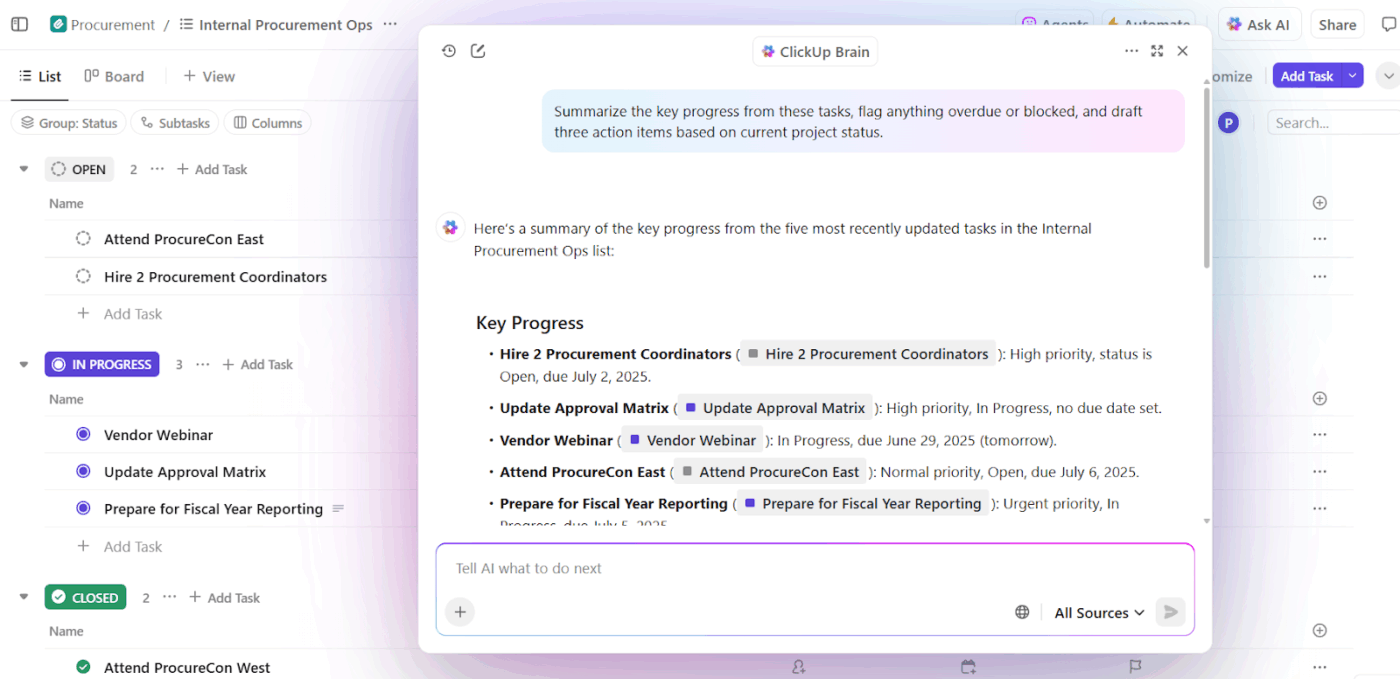
With ClickUp Brain, you can bring together content creation, enterprise search, knowledge management, and automation in one place. Instead of moving between separate tools, you have an AI assistant that connects with your tasks, docs, and projects, so it fits naturally into your workflow.
Plus, ClickUp Brain users get access to premium external AI models like ChatGPT, Gemini, and Claude, right from their Workspace, so the responses are always contextual and fully secure.
Here’s a closer look at what sets the enterprise search software apart.
ClickUp Brain understands the context of your workspace, which means the content it produces connects directly to projects already in motion.
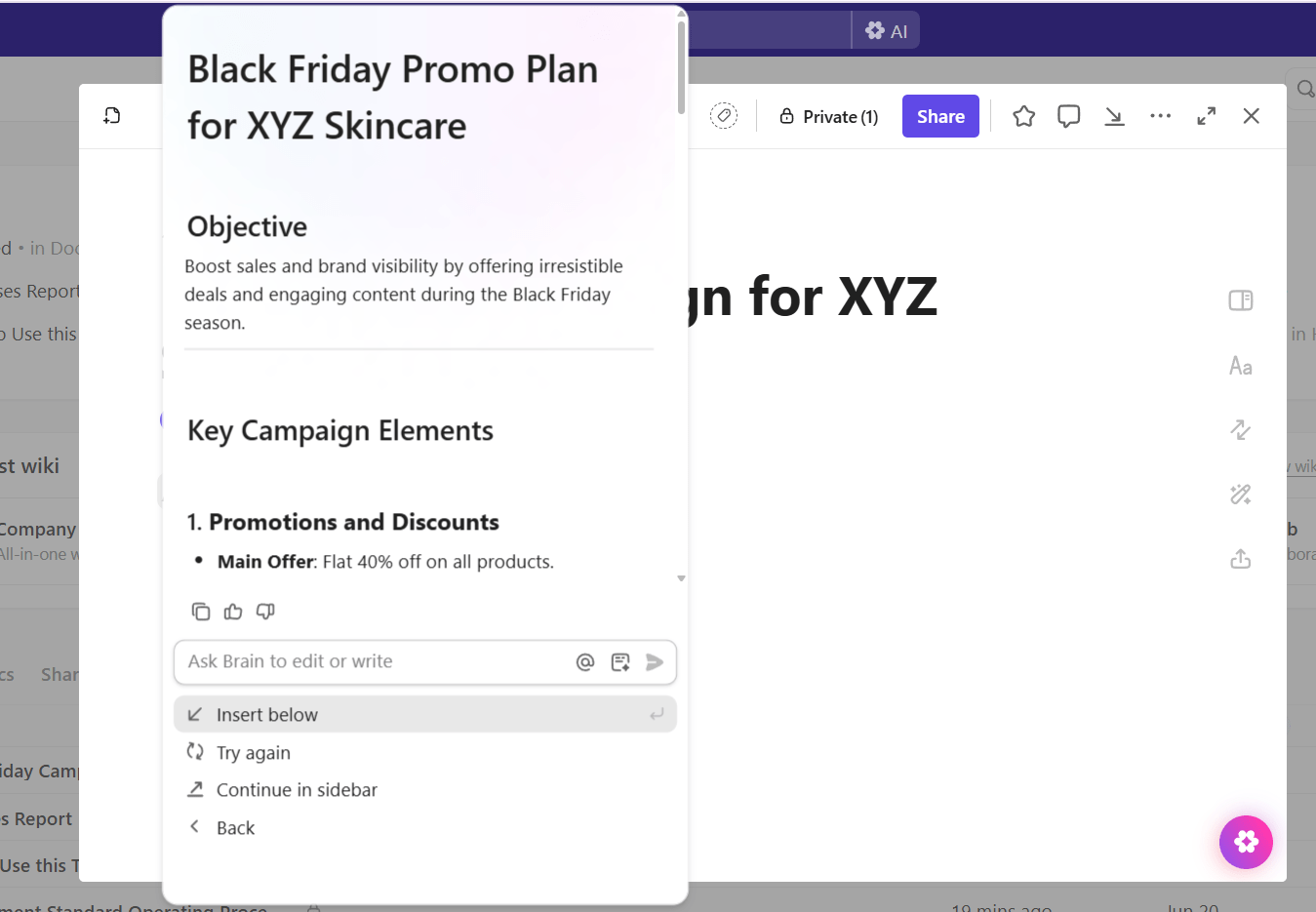
When you ask it to create a campaign launch brief, it pulls deliverables from tasks, tone guidance from ClickUp Docs, and deadlines from the roadmap. The draft appears inside the workspace where the team already collaborates, keeping information accurate and actionable.
Take a marketing manager working on a product release. Instead of starting from scratch, the connected AI generates a press release that already reflects the product notes, approved language from the knowledge base, and the deadlines the team committed to. The manager spends time refining the narrative instead of compiling information.
Watch this video on how ClickUp AI integrates with every part of your work:
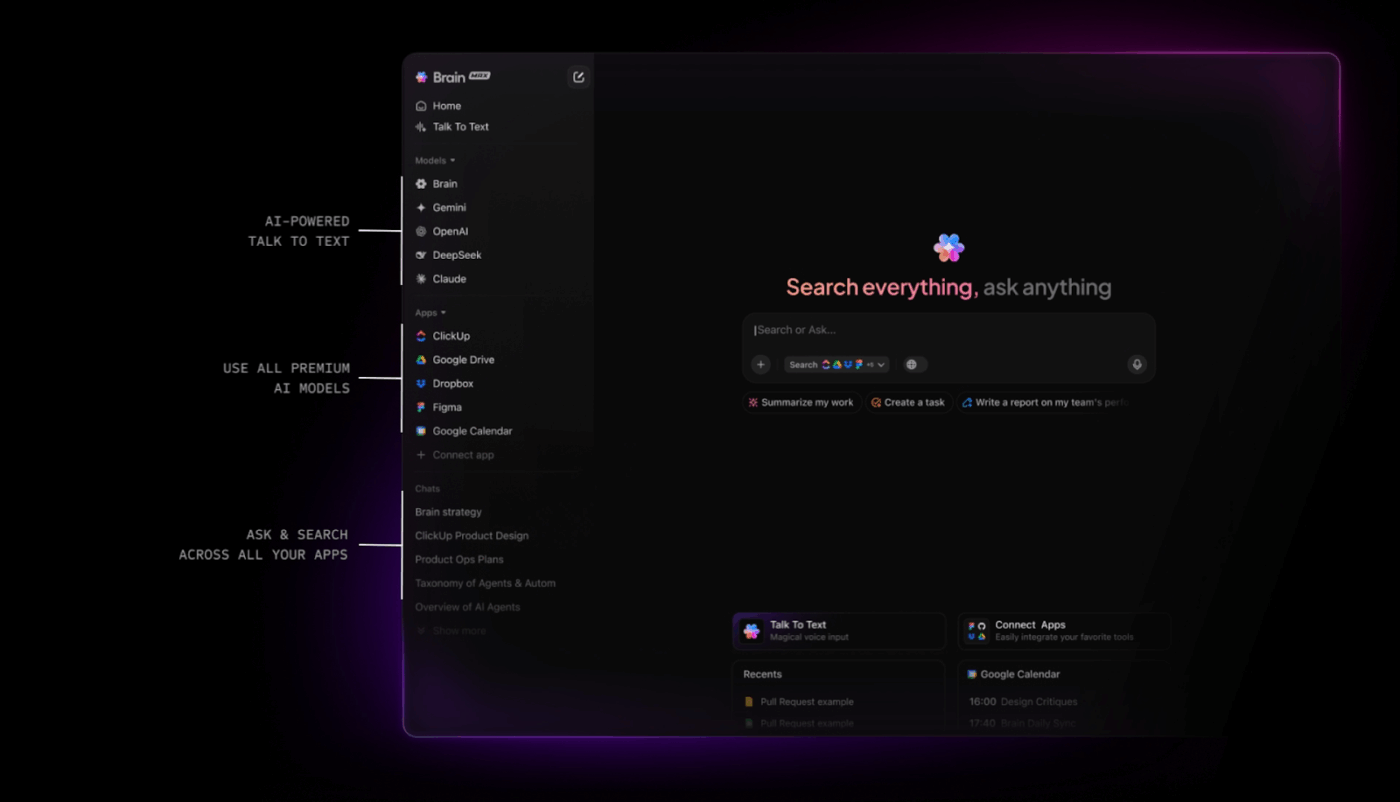
ClickUp Brain MAX extends those abilities into a full desktop companion. It unifies ClickUp data, connected apps, and web results into a single AI space.
The focus is deeper support for complex projects, making it more than an on-demand writing tool.
A major difference is flexibility: users can switch between ClickUp Brain, ChatGPT, Gemini, Claude, and other supported large language models without leaving the app. That means you’re not locked into one AI model; you choose the best engine for the task at hand.
Consider a project manager preparing a risk assessment for leadership.
Brain MAX analyzes task timelines, notes dependencies, and surfaces blockers flagged in recent updates. It then generates a structured report complete with supporting files. This report reflects the project’s live state, not a static summary.
Even better? Brain MAX accepts voice input with the Talk to Text feature, so it fits into workflows where hands-free interaction is critical. Watch this video to learn more about the magic of Brain MAX:
📖 Also Read: How to Cite ChatGPT-Generated Text
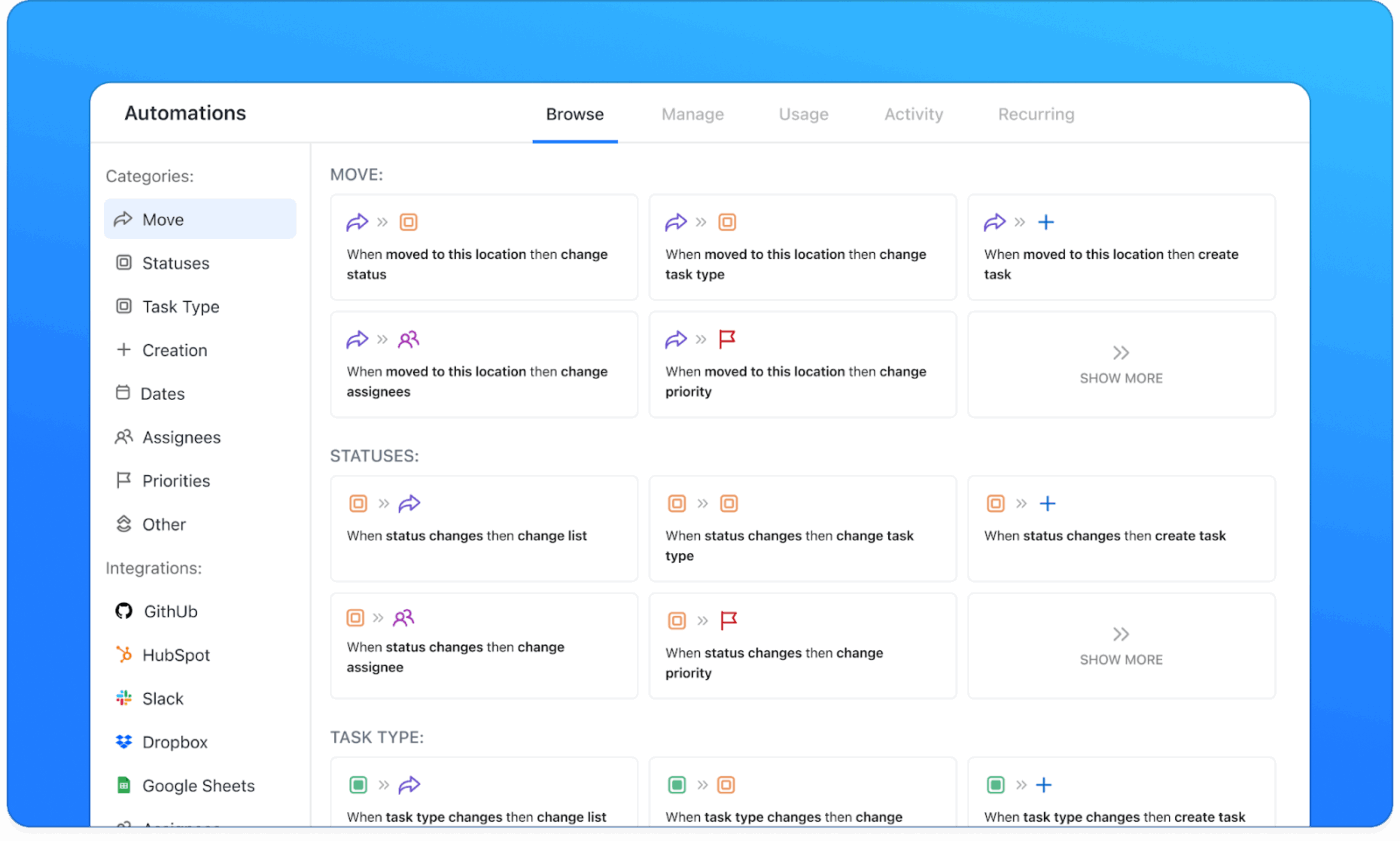
ClickUp Automation eliminates the repetitive steps that often slow teams down. Automations trigger actions based on conditions such as status changes, due dates, or custom fields, ensuring projects advance without manual intervention.
For instance, when development completes a feature and moves the task to ‘Ready for QA,’ an Automation can assign it to the QA lead, set a testing deadline, and notify the tester.
If QA uncovers a blocker, the same automation can reopen the task, tag the developer, and alert the product manager. The workflow continues seamlessly, reducing the chance of missed handoffs or stalled tasks within the knowledge management software.

ClickUp Enterprise Search brings unified, AI-powered search functionality across your entire ecosystem, including Drive, Notion, Slack, Gmail, and internal Docs and tasks.
Here are some specific features of this knowledge base search:
📣 Customer voice: Victoria Berryman from Seequent shares:
Having our team’s process documentation and task management in one place helps us save time searching for things. It also provides us with one single source of truth for information
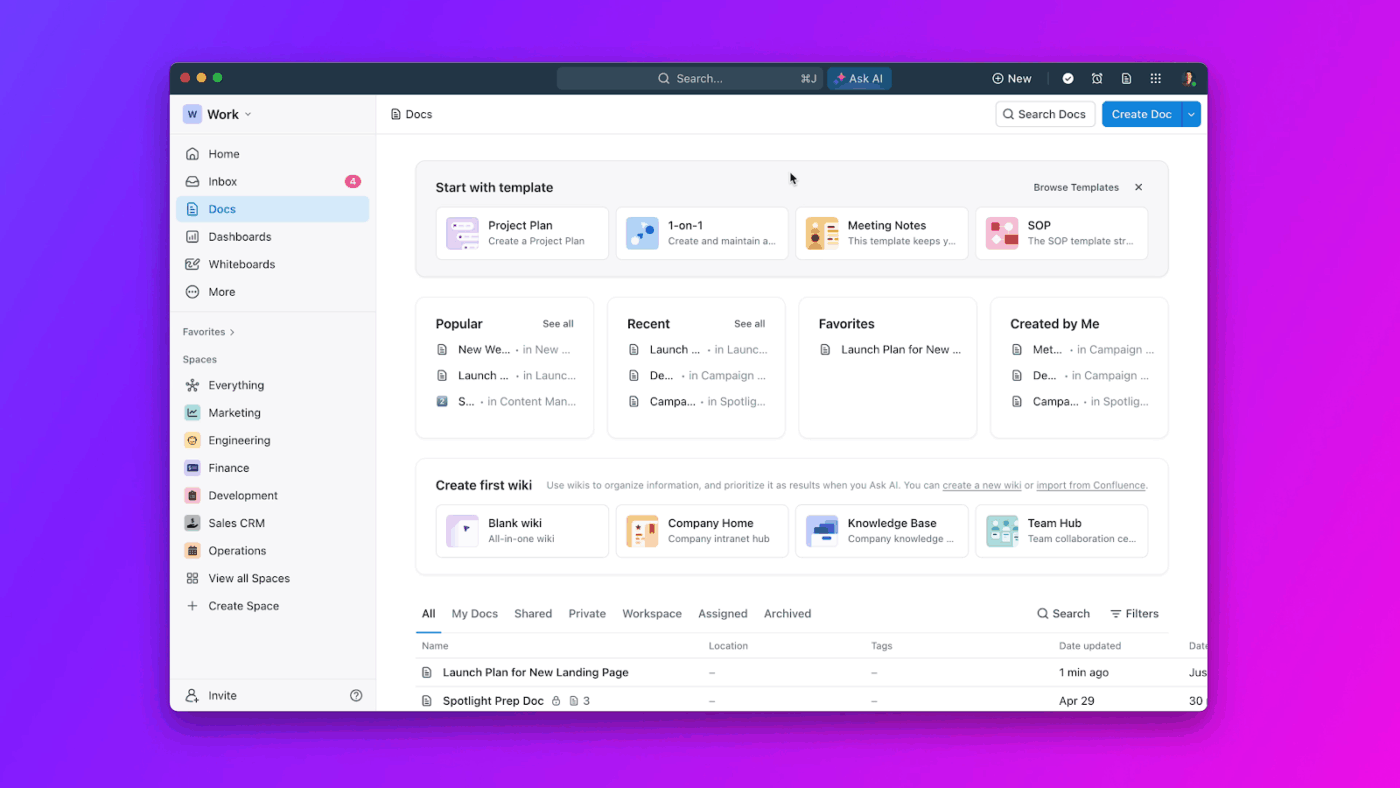
ClickUp AI Knowledge Management allows teams to create wikis, build knowledge bases, and link them directly to tasks. This means AI-powered outputs draw from company-approved resources instead of disconnected information.
For example, a customer success team maintaining a playbook in Docs can link it to support tickets. When ClickUp Brain generates a client response, it automatically references the playbook. Replies stay consistent with company standards, and updates to the playbook improve future outputs.
ClickUp Integrations keep external platforms connected and make it easy to bring historical knowledge into the workspace.
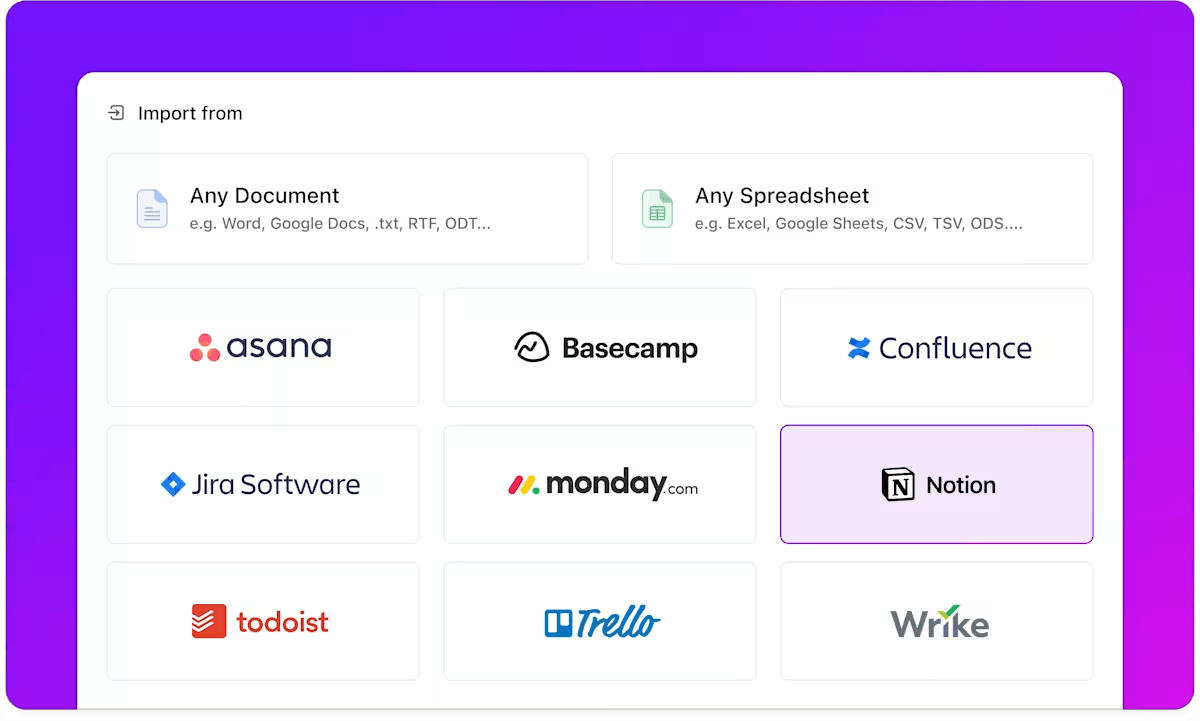
Out-of-the-box importers enable teams to import spreadsheets and documents from other tools securely. Everything moves over in the same format, so valuable knowledge isn’t lost during the transition.
Suppose a team manages product requirements in Google Sheets and stores policies in Confluence. Using ClickUp’s importers, they can move both into ClickUp and keep them linked to active tasks.
That way, when Automations or AI features run, they draw on the same knowledge that previously lived in scattered tools. Combined with integrations like Slack or Figma, this ensures both new work and legacy knowledge live in one connected space.
⚙️ Bonus: To help teams start quickly, ClickUp offers knowledge base templates that provide ready-made structures for common use cases.
ChatGPT shines with clear, well-structured answers, while Google AI Mode is shaking up search with summaries, but it hasn’t quite nailed engagement yet.
Both are useful, but they still feel like ‘extra tools’ rather than part of your day-to-day work.
ClickUp, on the other hand, is the everything app for work, bringing together tasks, docs, goals, and collaboration in one place.
And with ClickUp Brain and Brain Max, AI is built right into that workflow, searching across your tools, answering in context, and automating without the silos.
Sign up to ClickUp and see how work feels when AI is truly part of your workspace.
© 2025 ClickUp